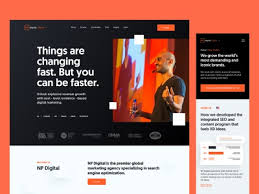
Creating Effective Marketing Website Design: A Guide to Success
The Importance of Website Design in Marketing
In the digital age, a well-designed website is crucial for any successful marketing strategy. Your website is often the first point of contact with potential customers, and it needs to make a lasting impression. Effective website design goes beyond aesthetics – it plays a significant role in engaging visitors, building trust, and driving conversions.
First Impressions Matter
Your website’s design is the first thing visitors notice when they land on your site. A visually appealing and user-friendly design can captivate users and encourage them to explore further. On the other hand, a poorly designed website can deter visitors and lead to high bounce rates. Investing in professional website design is essential for creating a positive first impression and establishing credibility.
User Experience (UX) is Key
A well-designed website focuses on providing an exceptional user experience (UX). Navigation should be intuitive, content should be easy to find, and the overall layout should guide users through the site seamlessly. A positive UX keeps visitors engaged and encourages them to take desired actions, such as making a purchase or contacting your business.
Responsive Design for Accessibility
In today’s mobile-centric world, responsive design is non-negotiable. Your website must be optimised for various devices and screen sizes to ensure a consistent experience across all platforms. Mobile responsiveness not only improves user experience but also boosts your search engine rankings, as search engines prioritise mobile-friendly sites.
Branding and Consistency
Your website is an extension of your brand identity. Consistent branding elements such as colours, fonts, and imagery help reinforce brand recognition and build trust with visitors. A cohesive design that aligns with your brand values strengthens your marketing efforts and sets you apart from competitors.
Conversion Optimisation
Effective website design goes hand in hand with conversion optimisation. Strategic placement of call-to-action buttons, clear messaging, and streamlined checkout processes can significantly impact conversion rates. By designing your website with conversions in mind, you can maximise the effectiveness of your marketing campaigns.
Conclusion
Website design plays a critical role in the success of your marketing efforts. By investing in professional, user-centric design that aligns with your brand identity and focuses on delivering an exceptional user experience, you can enhance engagement, build credibility, and drive conversions. Remember, your website is often the face of your business online – make it count!
Essential Tips for Effective Marketing Website Design: A Guide to Engaging and Optimised User Experience
- Ensure your website is visually appealing and aligns with your brand identity.
- Optimize your website for mobile devices to cater to users on-the-go.
- Create clear and concise navigation to help visitors easily find information.
- Include high-quality images and videos to engage users and showcase products/services.
- Utilize white space effectively to improve readability and create a clean design.
- Incorporate strong calls-to-action to guide visitors towards desired actions.
- Make sure your website loads quickly to prevent users from losing interest.
- Implement SEO best practices to improve visibility in search engine results.
- Regularly update content and stay current with design trends for a fresh look.
Ensure your website is visually appealing and aligns with your brand identity.
It is essential to ensure that your website is visually appealing and aligns seamlessly with your brand identity. A visually engaging design not only captivates visitors but also reinforces brand recognition. Consistency in branding elements such as colours, fonts, and imagery helps establish trust and credibility with your audience. By harmonising your website’s aesthetics with your brand identity, you create a cohesive online presence that resonates with visitors and strengthens your overall marketing strategy.
Optimize your website for mobile devices to cater to users on-the-go.
In today’s fast-paced digital landscape, it is essential to optimise your website for mobile devices to cater to users who are constantly on-the-go. With the increasing use of smartphones and tablets, ensuring that your website is responsive and mobile-friendly is crucial for providing a seamless user experience. By prioritising mobile optimisation in your website design, you not only enhance accessibility for a wider audience but also improve search engine rankings and user engagement. Embracing mobile responsiveness is key to staying competitive and meeting the evolving needs of modern consumers.
Create clear and concise navigation to help visitors easily find information.
Creating clear and concise navigation on your website is essential for ensuring that visitors can easily find the information they are looking for. By organising your navigation in a logical manner and using descriptive labels, you can guide users to the content they seek efficiently. Clear navigation not only enhances the user experience but also reduces frustration and encourages visitors to explore more of your site, ultimately leading to higher engagement and conversions.
Include high-quality images and videos to engage users and showcase products/services.
Including high-quality images and videos on your website is a powerful strategy to engage users and effectively showcase your products or services. Visual content not only captures attention but also conveys information in a more compelling and memorable way. By incorporating visually appealing media, you can create a more immersive experience for visitors, helping them better understand what you have to offer and encouraging them to explore further. High-quality images and videos can enhance the overall aesthetic appeal of your website, build credibility, and ultimately drive conversions by showcasing your offerings in the best possible light.
Utilize white space effectively to improve readability and create a clean design.
When it comes to marketing website design, utilising white space effectively can significantly enhance readability and create a clean, visually appealing layout. White space, or negative space, helps to reduce clutter and allows content to breathe, making it easier for visitors to focus on the important information. By strategically incorporating white space around text, images, and other elements, you can improve the overall user experience and convey a sense of sophistication and professionalism on your website.
Incorporate strong calls-to-action to guide visitors towards desired actions.
Incorporating strong calls-to-action (CTAs) is a crucial tip in marketing website design. By strategically placing clear and compelling CTAs throughout your website, you can effectively guide visitors towards desired actions, such as making a purchase, signing up for a newsletter, or contacting your business. Well-crafted CTAs not only enhance user engagement but also play a key role in driving conversions and maximising the effectiveness of your marketing campaigns.
Make sure your website loads quickly to prevent users from losing interest.
Ensuring that your website loads quickly is crucial in marketing website design. In today’s fast-paced digital environment, users expect instant access to information. A slow-loading website can lead to frustration and a high bounce rate, causing potential customers to lose interest and seek alternatives. By prioritising fast loading speeds, you can create a seamless user experience that keeps visitors engaged and more likely to explore your content and offerings. Fast-loading websites not only improve user satisfaction but also contribute to higher search engine rankings, ultimately enhancing the effectiveness of your marketing efforts.
Implement SEO best practices to improve visibility in search engine results.
By implementing SEO best practices in your website design, you can enhance your visibility in search engine results. Optimising your site for search engines ensures that your content is easily discoverable by users searching for relevant information or services. By incorporating SEO techniques such as keyword research, meta tags optimisation, and quality content creation, you can improve your website’s ranking and attract more organic traffic. A well-optimised website not only increases visibility but also enhances user experience, ultimately leading to better engagement and conversions.
Regularly update content and stay current with design trends for a fresh look.
To maintain a visually appealing and engaging website, it is essential to regularly update content and stay current with design trends. By refreshing your content and incorporating the latest design elements, you can give your website a fresh look that resonates with visitors. Keeping up with design trends not only enhances the aesthetic appeal of your site but also demonstrates that your brand is dynamic and forward-thinking. Embracing regular updates ensures that your website remains relevant, captivating, and in line with evolving user expectations.

